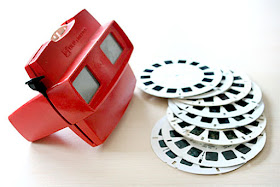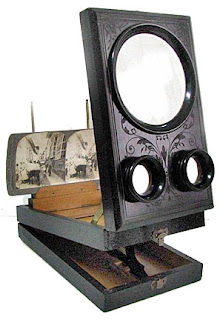 QUESTION: When I was a kid in the 1950s, I received a View-Master stereoscope for Christmas. It came with several reels of photos, plus I could buy additional ones. I loved viewing photos of my favorite TV show characters, especially the westerns, as well as scenes of faraway places. As an adult, I continued my fascination with the stereoscope when I discovered an antique one at a fleamarket. It came with a box of paired photos mounted on cardboard. I’ve always wondered how the stereoscope came about? Can you give me some insight into its history?
QUESTION: When I was a kid in the 1950s, I received a View-Master stereoscope for Christmas. It came with several reels of photos, plus I could buy additional ones. I loved viewing photos of my favorite TV show characters, especially the westerns, as well as scenes of faraway places. As an adult, I continued my fascination with the stereoscope when I discovered an antique one at a fleamarket. It came with a box of paired photos mounted on cardboard. I’ve always wondered how the stereoscope came about? Can you give me some insight into its history?
ANSWER: A stereoscope was an instrument in which two photographs of the same object, taken from slightly different angles, could simultaneously be presented, one to each eye. This recreated the way which in natural vision, each eye views an object from a slightly different angle, separated by several inches. This is what gives humans natural depth perception. A separate lens focused each picture, and by showing each eye a photograph taken several inches apart from each other and focused on the same point, the stereoscope recreated the natural effect of seeing things in three dimensions.
 Sir Charles Wheatstone invented the earliest stereoscopes, which optician R. Murray made for him in 1832. On June 21, 1838, Wheatstone gave a presentation of his invention at the Royal College of London in which he used a pair of mirrors at 45 degree angles to the user's eyes, each reflecting a picture located off to the side. It demonstrated the importance of binocular depth perception by showing that when two pictures simulating left-eye and right-eye views of the same object are presented so that each eye sees only the image designed for it, but apparently in the same location, the brain will fuse the two and accept them as a view of one solid three-dimensional object. Unfortunately, Wheatstone introduced his stereoscope the year before the first practical photographic processes became available, so he had to use drawings at first. This mirror stereoscope allowed two pictures to be used if desired.
Sir Charles Wheatstone invented the earliest stereoscopes, which optician R. Murray made for him in 1832. On June 21, 1838, Wheatstone gave a presentation of his invention at the Royal College of London in which he used a pair of mirrors at 45 degree angles to the user's eyes, each reflecting a picture located off to the side. It demonstrated the importance of binocular depth perception by showing that when two pictures simulating left-eye and right-eye views of the same object are presented so that each eye sees only the image designed for it, but apparently in the same location, the brain will fuse the two and accept them as a view of one solid three-dimensional object. Unfortunately, Wheatstone introduced his stereoscope the year before the first practical photographic processes became available, so he had to use drawings at first. This mirror stereoscope allowed two pictures to be used if desired.
 Though David Brewster didn’t invent the stereoscope, he built a simple stereoscope without lenses or mirrors, consisting of a wooden box 18 inches long, 7 inches wide, and 4 inches high, which he used to view drawn landscape transparencies. In 1849, he suggested using lenses to unite the dissimilar pictures. This allowed a reduction in picture size, creating hand-held devices, which became known as Brewster Stereoscopes, which Queen Victoria admired when he demonstrated them at the Great Exhibition of 1851.
Though David Brewster didn’t invent the stereoscope, he built a simple stereoscope without lenses or mirrors, consisting of a wooden box 18 inches long, 7 inches wide, and 4 inches high, which he used to view drawn landscape transparencies. In 1849, he suggested using lenses to unite the dissimilar pictures. This allowed a reduction in picture size, creating hand-held devices, which became known as Brewster Stereoscopes, which Queen Victoria admired when he demonstrated them at the Great Exhibition of 1851.
 But Brewster couldn’t find a British instrument maker capable of constructing his design, so he took it to France, where Jules Duboscq , who made stereoscopes and stereoscopic daguerreotypes, improved the design, allowing the display of Queen Victoria’s likeness to be displayed at The Great Exhibition. Thanks to her, stereoscopes became a huge success, with 250,000 of them produced, along with a great number of stereoviews, stereo cards, stereo pairs or stereographs. Stereoscope makers sent stereographers throughout the world to capture views for the new medium and feed the demand for 3D images. They then had cards printed with these views often with explanatory text. When a user looked at them through the double-lensed viewer, also called a stereopticon, they could see both.
But Brewster couldn’t find a British instrument maker capable of constructing his design, so he took it to France, where Jules Duboscq , who made stereoscopes and stereoscopic daguerreotypes, improved the design, allowing the display of Queen Victoria’s likeness to be displayed at The Great Exhibition. Thanks to her, stereoscopes became a huge success, with 250,000 of them produced, along with a great number of stereoviews, stereo cards, stereo pairs or stereographs. Stereoscope makers sent stereographers throughout the world to capture views for the new medium and feed the demand for 3D images. They then had cards printed with these views often with explanatory text. When a user looked at them through the double-lensed viewer, also called a stereopticon, they could see both.
 In 1861 Oliver Wendell Holmes created but deliberately didn’t patent a handheld, streamlined, much more economical viewer than had been available before. This stereoscope from the 1850s, consisted of two prismatic lenses and a wooden stand to hold the stereo card. This type of stereoscope remained in production for a century and is the type most associated with the name.
In 1861 Oliver Wendell Holmes created but deliberately didn’t patent a handheld, streamlined, much more economical viewer than had been available before. This stereoscope from the 1850s, consisted of two prismatic lenses and a wooden stand to hold the stereo card. This type of stereoscope remained in production for a century and is the type most associated with the name.
Another type of viewer was the multiple view stereoscope which allowed viewing multiple stereoscopic images in sequence by turning a knob or crank, or pushing down a lever. Antoine Claudet patented the first one in 1855, but the design of Alexander Beckers from 1857 formed the basis for many revolving stereoscopes manufactured from the 1860s onward. The user placed the images in holders attached to a rotating belt. The belt could usually hold 50 paper card or glass stereoviews, but there were also large floor standing models capable of holding 100 or 200 views.
A more advanced multiple view stereoscope was only intended for glass slides and was especially popular in France, as the printing of stereo images on glass was a French specialty popular until the 1930s. The French made most of these devices, but ICA and Ernemann also made them in Germany. Users placed the glass slides in a bakelite or wooden tray. Turning a crank or pushing down a lever to lift a slide from the tray, bringing it into the viewing position. Turning further placed the slide back in the tray and moved the tray over a rail to select the next slide. The most sophisticated and well known design was the Taxiphote by Jules Richard, patented in 1899.
In the mid-20th century, the View-Master stereoscope, first patented in 1939, featured a rotating cardboard disk which contained image pairs. It was originally popular as a way for people to virtually travel to faraway places, but by the 1950s had become a popular toy.
To read more articles on antiques, please visit the Antiques Articles section of my Web site. And to stay up to the minute on antiques and collectibles, please join the over 30,000 readers by following my free online magazine, #TheAntiquesAlmanac. Learn more about "Coffee--The Brew of Life" in the 2023 Summer Edition, online now. And to read daily posts about unique objects from the past and their histories, like the #Antiques and More Collection on Facebook.





No comments:
Post a Comment
If you liked my post or have additional information to add, please fill out this form.